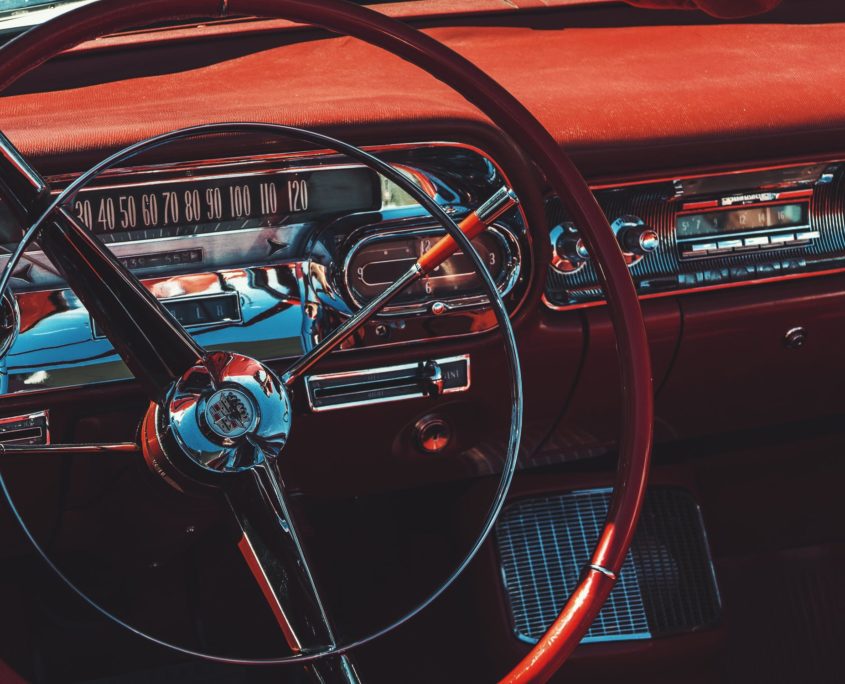How To Clean Speedometer Repair Shop For Model A
All vintage car enthusiasts love the style and character of musical instrument panels behind the steering cycle in classic cars. Unfortunately, with historic period, neglect, and careless add-ons, vintage gauge clusters can become degraded and present problems. Eventually, they volition have to be restored or replaced which offers an opportunity to upgrade with new technology as well as the power to customize with unique color, style, and features.
How to Repair and Restore a classic Motorcar Instrument Gauge Cluster
Beneath are some common issues that may occur with old instruments and how to fix them:
Switching from Amp to Volts
Older classic cars with ammeters that read amps instead of volts were designed for a maximum reading of 40 – 50 amps. If a high-amperage alternator is installed the ammeter and wires surrounding it will get too hot, causing the wires to melt and at worst grab fire. To prevent or fix this problem the guess needs to be switched from amps to volts.

Speedometer Accuracy
The speedometer's accuracy can be checked by using a GPS app on an iPhone. If the reading is too high, adding teeth to the gear that is attached to the opposite side of the cablevision bolted to the transmission, volition slow it down. Subtracting teeth will speed up the reading.
Bouncing Speedometer Needle
If the speedometer needle bounces while traveling at low speed, there is virtually likely a problem with the cable. Pull the cablevision out of its casing, clean it with a product like WD-40, and lubricate it with wheel-bearing grease earlier replacing.
If the needle bounces and there is a noise while traveling at a higher speed, there could be a problem with the speedometer itself which will accept to be taken to a reputable vintage car repair shop to be fixed.
Converting Odometer to Digital
Irresolute the transmission to utilize a speed sensor instead of the original speedometer cablevision ways that it can be converted to GPS. This will turn the odometer to a digital display set to nix. If you are going to prove your vintage machine at expos run by organizations like Classic Automobile Club of America (CCCA) or Antique Car Society of America (AACA), so you probably don't desire to switch to a digital speedometer and other gauges. And if your car falls under the "antiquarian class" you definitely should not switch. But, if you are just restoring a classic to drive around a digital cluster can look pretty cool.
Installing Solid-country Voltage Regulator
Virtually vintage guess clusters have a pocket-size box that is actually a points-style voltage regulator. When the points in the regulator stick, all the gauges can be pegged at in one case by the voltage, shorting them out. The solution is to replace the points-way regulator with a solid-state voltage regulator.
Reducing the Guess Input Voltage
Considering vintage controls are frequently designed for five and not 12 volts, a voltage regulator must be used to daisy-chain together the power studs that will lower the judge input voltage.
Preserving the Pointers
With the correct awarding of a white basecoat and carmine-orange fluorescent paint, the pointers can be redone. This job is all-time done by a professional person to preserve the balance of the pointers.
Restoring Numbers and Hash Marks
Numbers and hash marks on the face up of the gauge can be restored. Professional companies can customize it to feature any color, font or artwork desired.
Restoring the Drinking glass
The glass on the face of the judge can be restored past using Meguiar's glass smooth and 000 steel wool. The outer bezel can exist painted, powder-coated, or sandblasted to the original factory colors.
Tach Adapter and New Internals
A factory tachometer volition not work with an aftermarket tach signal. Professional companies can at present convert any mill tach to operate with aftermarket signals by using new internals and a tach adapter.
Gauges Found on Vintage Cars
The all-time classic automobile instruments are truly handcrafted or restored works of fine art individually and painstakingly recreated to exacting standards. Especially if your vehicle is a Contumely Era car. Each gauge is assembled with carefully selected components and inspected for visual integrity and tested for accuracy and calibration. Modern engineered instruments are produced with a vintage-style face blueprint and electronic programmable speedometers for classic cars.
Customization to Feature Artwork and Colors
Exclusive customization options for gauges have opened up opportunities for amazing individual inventiveness. While classic instrumentation remains at the forefront of creative design, retrofit engineering has made modern electronic instruments available for even the nigh sophisticated dashboards. A wide range of option is available in standard line gauges for custom-built vehicles.
Instrument clusters provide vehicle manufacturers with an invaluable opportunity for differentiation through fashion, features, color, and customization. Products include gauges, cables, accessories, sender units, and the new 'SkyDrive' applied science with satellite speedometer electronic control units.
Instrument clusters accept been evolving dramatically, and the change of pace is likely to quicken due to improvements in digital HMI (Human Machine Interface) and an intense focus on vehicle safety.
Source: https://www.dicksspeedotach.com/classic-car-gauge-restoration/
Posted by: evansnakenceral74.blogspot.com


0 Response to "How To Clean Speedometer Repair Shop For Model A"
Post a Comment